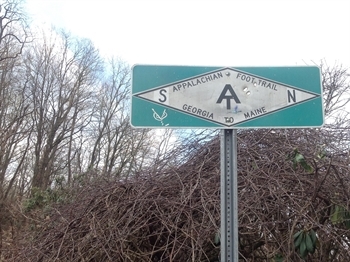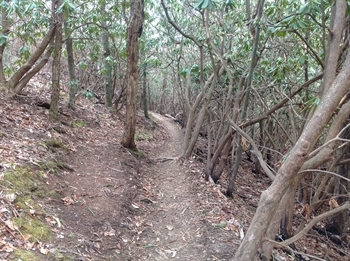[All apologies for the fact that my reflections keep getting longer. March had good adventures, and it all fits together, and it's so nice to write things that aren't grant reports.]

The Setup
One of my personal goals is to visit all 50 states before turning 30, so after working every single day from January 2 through March 17 (thank you, second job), I took a week off to address this ambition. Off-beat road trips are my favorite--last summer, I drove south along the Mississippi River until the road ended; in December, I followed an amazing secondary highway from Sterling, North Dakota down into Nebraska to visit Bailey Yard; this summer, you won’t hear from me for a week because I’ll be in Wyoming, camping in a fire tower--so of course I drove away on March 18 with goals of solo-hiking a very small stretch of the Appalachian Trail in North Carolina (plus a bonus detour to South Carolina). I would be lying by omission if I didn’t say I was nervous: I spent my first mile of trail with pepper spray at-the-ready and came embarrassingly close to incapacitating a squirrel that ran out in front of me. But as this fear subsided, I soon found myself enjoying the risk of walking alone through an unfamiliar place.
Back when none of us knew what Future Ready really was but felt compelled to apply anyway, a question on the application addressed our willingness to take risks. After moving beyond concern (what activities were planned for our workshop in Atlanta? would we be zip-lining from the top of our hotel? would we have to wrangle venomous snakes? or, worse yet, would we have to do trust falls?), I found this question refreshing. So often, large-scale guided projects like this dance around the notion of risk. This absence, in turn, invalidates the sense of risk participants may experience and creates dissonance between project expectations and individual realities. But Future Ready--from the very start--asked us to face risk directly. Risk is real, here and elsewhere, and by confronting it, we can move further in our work.

The Risk
On its surface, in modern English, risk suggests danger during the process of trying to achieve a goal, but etymological retellings provide more depth: Imagine Odysseus, lone shipwreck survivor lost in the world, clinging to the roots of a tree on the edge of a cliff. The transcribed word Homer gave those roots was rhiza, which the Romans adapted as the Latin risicum, often meaning cliff, which over centuries of mispronunciations and misunderstandings (and by way of my reductive explanation) eventually became today’s risk. Risk is more than a possibility of danger; it’s a liminal space--or transition zone (like adolescence)--located somewhere between here and there, between safety and disaster, between what happened and what happens next. In our Future Ready activities, we discuss at-risk middle school youth as if they too, like Odysseus, are lost and alone and dangling from a root at the edge of a cliff, suspended in liminality between solid ground and churning water.
The Appalachian Trail is a 2,190-mile liminal space, a single thread connecting fourteen states without belonging to any and spanning countless ecosystems and climates and altitudes. Its hikers include people from across the country and around the world who, really, are only on the trail temporarily, suspended between what came before and what comes next. Despite its popularity, the AT overpowers most thru-hikers: In 2016, out of the estimated 3,867 people who set out to thru-hike the AT, only 18% reported success. I tried not to think about this statistic as I spoke with northbound hikers--two weeks into their six-month trek--but it was hard to forget when the man from Kansas and the woman from Virginia and the mother-daughter duo from Colorado all paused for a moment during our conversations, then revised their self-identification as thru-hikers with things like, “That’s the goal, anyway.” Risk never vanishes; thru-hikers just learn to carry it.
In my own work for Future Ready, I’ve entered a kind of liminal space, an in-between time where risk is palpable. Discussing CCR for middle school youth within the confines of our cohort is safe and familiar, so taking that dialog out into my community made me nervous at first. But the conversations I had with employees in Gaming, within the Education Division, in the Family Education program, and at the Telecom office were all positive. Gaming, in particular--as a cornerstone of the local economy and the largest non-governmental employer on the reservation--has the most accessible opportunities for Future Ready, I think. Last year, Gaming’s training department offered a summer-long program for middle school and high school youth, where kids shadowed employees full-time. “These are my future managers,” the training director said, noting high turnover and envisioning a more stable future. But she saw the younger kids were often bored; with workplace age restrictions effective, they weren’t allowed to do any actual work. We’ve begun talking about enhancing their experience with activities at the library, possibly using our set of iPads, robotics kits, and Legos to encourage digital literacy skills.

The New Viewpoint
Ultimately, risk--with its meaning rooted in actual roots--is itself the root of change anytime we reconcile possibilities of failure with goals of progress. Here in these liminal moments, we’re separated from our usual patterns, which gives us the opportunity to think more creatively, test our limits, learn as we go, and see things from a new viewpoint (and isn’t this also what middle school and adolescence are about?). But it can be frightening. With one hand gripping pepper spray as I hiked, I kept reminding myself that I chose the AT, that I’m the one who put myself in the car and started the engine and drove and drove and drove, that even if I couldn’t control specifics (like unpredictable squirrel attacks), I could still choose to keep going, to not turn back early. Our Future Ready activities up until this month have walked us step-by-step toward taking a risk, and now that we’ve finally reached out, it’s nearly time to find a community partner, trust them, and make the decision to not let go.
Bonus picture, of course, because guess who turns 1 soon!:

New favorite toy: a package of bookmarks